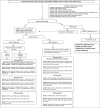Comparison of the effects PRICE and POLICE treatment protocols on ankle function in patients with ankle sprain
- PMID: 37563900
- PMCID: PMC10560804
- DOI: 10.14744/tjtes.2023.29797
Comparison of the effects PRICE and POLICE treatment protocols on ankle function in patients with ankle sprain
Abstract
Background: Ankle sprain is a frequent reason for presentation to the emergency department. Current treatment modalities include Protection, Optimal Loading, Ice, Compression, and Elevation (POLICE) and Protection, Rest, Ice, Compression, and Elevation (PRICE). This study aimed to compare the effects of PRICE and POLICE treatment protocols.
Methods: This randomized controlled study was conducted between October 15, 2020, and October 15, 2021, at Ankara University's Department of Emergency Medicine. Double-blind randomization was used to assign patients to either the POLICE or PRICE treatment groups.
Results: In total, 109 patients were included. In the POLICE group, the median difference between the American Orthopedic Foot and Ankle Scores on admission and the 14th day following the injury was 34.5 (IQR: 27.25-41.75), while that of the PRICE group was 24 (IQR: 15.5-35). In the POLICE group, the median value of the difference in the Foot and Ankle Disability Index scores on admission and the 14th day following the injury was 42 (IQR: 35.25-50), while that of the PRICE group was 31 (IQR: 22-41.5).
Conclusion: The POLICE treatment protocol provided more effective and faster recovery than the PRICE treatment protocol.
Conflict of interest statement
Figures
References
-
- Fallat L, Grimm DJ, Saracco JA. Sprained ankle syndrome:Prevalence and analysis of 639 acute injuries. J Foot Ankle Surg. 1998;37:280–5. - PubMed
-
- Chen ET, McInnis KC, Borg-Stein J. Ankle sprains:Evaluation, rehabilitation, and prevention. Curr Sports Med Rep. 2019;18:217. - PubMed
-
- Glasgow P, Phillips N, Bleakley C. Optimal loading:Key variables and mechanisms. Br J Sports Med. 2015;49:278–9. - PubMed
-
- Tully MA, Bleakley CM, O'Connor SR, McDonough SM. Functional management of ankle sprains:What volume and intensity of walking is undertaken in the first week postinjury. Br J Sports Med. 2012;46:877–82. - PubMed
Publication types
MeSH terms
Substances
LinkOut - more resources
Full Text Sources
Medical



